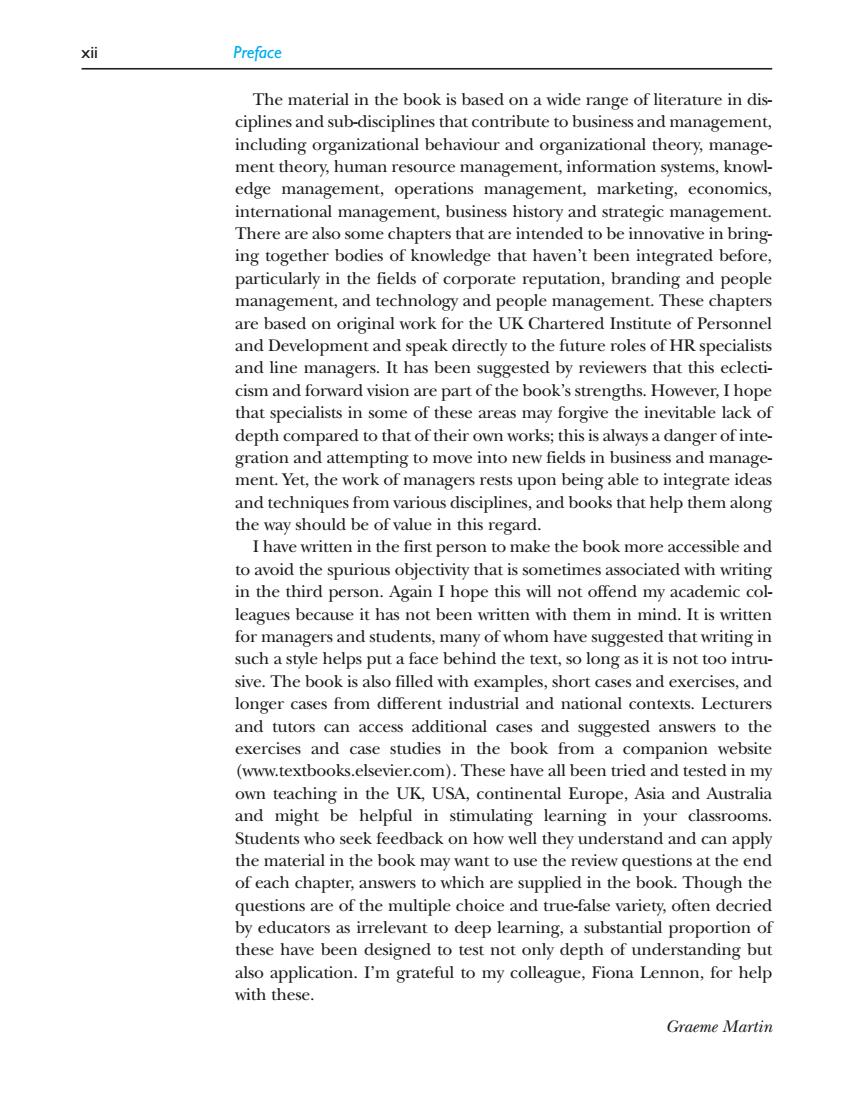正在加载图片...

Preface The material in the book is based on a wide range of literature in dis ciplines and sub-disciplines that contribute to business and management including organizational behaviour and organizational theory,manage ment theory,human resource management,information systems,knowl edge management,operations management,marketing,economics, international management,business history and strategic management There are also some chapters that are intended to be innovative in bring ing together bodies of knowledge that haven't been integrated before. particularly in the fields of corporate reputation,branding and people management,and technology and people management.These chapters are based on original work for the UK Chartered Institute of Personnel and Development and speak directly to the future roles of HR specialists and line managers.It has been suggested by reviewers that this eclecti- cism and forward vision are part of the book's strengths.However,I hope that specialists in some of these areas may forgive the inevitable lack of depth compared to that of their own works;this is always a danger of inte- gration and attempting to move into new fields in business and manage ment.Yet,the work of managers rests upon being able to integrate ideas and techniques from various disciplines,and books that help them along the way should be of value in this regard. I have written in the first person to make the book more accessible and to avoid the spurious objectivity that is sometimes associated with writing in the third person.Again I hope this will not offend my academic col- leagues because it has not been written with them in mind.It is written for managers and students,many of whom have suggested that writing in such a style helps put a face behind the text,so long as it is not too intru- sive.The book is also filled with examples,short cases and exercises,and longer cases from different industrial and national contexts.Lecturers and tutors can access additional cases and suggested answers to the exercises and case studies in the book from a companion website (www.textbooks.elsevier.com).These have all been tried and tested in my own teaching in the UK,USA,continental Europe,Asia and Australia and might be helpful in stimulating learning in vour classrooms Students who seek feedback on how well they understand and can apply the material in the book may want to use the review questions at the end of each chapter,answers to which are supplied in the book.Though the questions are of the multiple choice and true-false variety,often decried by educators as irrelevant to deep learning,a substantial proportion of these have been designed to test not only depth of understanding but also application.I'm grateful to my colleague,Fiona Lennon,for help with these. Graeme Martin The material in the book is based on a wide range of literature in disciplines and sub-disciplines that contribute to business and management, including organizational behaviour and organizational theory, management theory, human resource management, information systems, knowledge management, operations management, marketing, economics, international management, business history and strategic management. There are also some chapters that are intended to be innovative in bringing together bodies of knowledge that haven’t been integrated before, particularly in the fields of corporate reputation, branding and people management, and technology and people management. These chapters are based on original work for the UK Chartered Institute of Personnel and Development and speak directly to the future roles of HR specialists and line managers. It has been suggested by reviewers that this eclecticism and forward vision are part of the book’s strengths. However, I hope that specialists in some of these areas may forgive the inevitable lack of depth compared to that of their own works; this is always a danger of integration and attempting to move into new fields in business and management. Yet, the work of managers rests upon being able to integrate ideas and techniques from various disciplines, and books that help them along the way should be of value in this regard. I have written in the first person to make the book more accessible and to avoid the spurious objectivity that is sometimes associated with writing in the third person. Again I hope this will not offend my academic colleagues because it has not been written with them in mind. It is written for managers and students, many of whom have suggested that writing in such a style helps put a face behind the text, so long as it is not too intrusive. The book is also filled with examples, short cases and exercises, and longer cases from different industrial and national contexts. Lecturers and tutors can access additional cases and suggested answers to the exercises and case studies in the book from a companion website (www.textbooks.elsevier.com). These have all been tried and tested in my own teaching in the UK, USA, continental Europe, Asia and Australia and might be helpful in stimulating learning in your classrooms. Students who seek feedback on how well they understand and can apply the material in the book may want to use the review questions at the end of each chapter, answers to which are supplied in the book. Though the questions are of the multiple choice and true-false variety, often decried by educators as irrelevant to deep learning, a substantial proportion of these have been designed to test not only depth of understanding but also application. I’m grateful to my colleague, Fiona Lennon, for help with these. Graeme Martin xii Preface